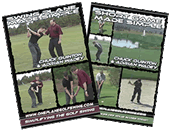by Chuck Quinton
Rotary Hitter Golf Swing |
Rotary Swing Golf |
FOR ADVANCED GOLFERS ONLY!!
I am often asked if I teach the Rotary Swing to my tour professionals exactly the same as I do amateurs. The simple answer is yes and no. The truth to it all is that every golfer has individual needs, tendencies and variations in their swing that require an instructor to work with and around. When working with a professional or very good amateur, there are thousands of hours of practice that have ingrained certain tendencies that aren't necessarily bad, but can be used to speed up progress by utilizing them rather than trying to train the golfer to do something completely new. When the livelihood of the golfer is at stake it's generally not a great idea to "fix what isn't broken" by teaching a golfer to do the opposite of what he has been doing for 20 years or more. As such, I modify my approach to teaching them to allow for these things and use them to the student's advantage.
So, how does this impact you? First off, understand that these topics are far more advanced and take much more time to master as they are more complex and intricate. It takes dozens and dozens of hours of consistent practice to begin to learn to perform them correctly. If you are not a solid single digit handicapper, athletic, and have a ton of free time on your hands to do nothing but practice golf, leave this section alone. So, why even publish this information if it's for only a small group of golfers? There are two reasons. First, this allows those golfers who have developed many of the fundamentals of the Rotary Swing but can't grasp keeping their arms passive an avenue to learn to swing the club and play at a high level without requiring them to keep their arms passive. Secondly, this gives the better golfer who has grooved many things in their swi


